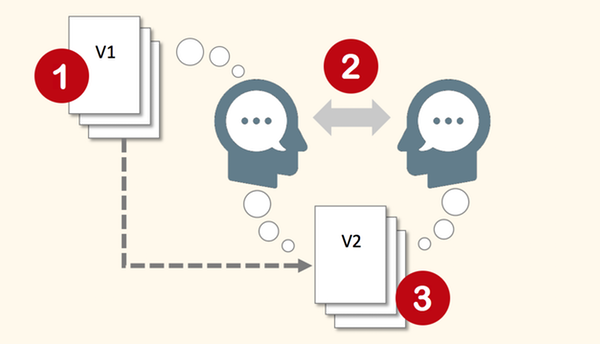This month we’re focussing on informal proposals—those submitted after conversations with a prospect, but outside a formal RFP process.
An informal proposal saves the buyer the time and effort of creating an RFP and managing the evaluation process. Meanwhile, the seller avoids the risk of an open competition—and retains control over the format and contents of the offer submitted.
For these reasons, it makes sense to invest ahead of time in building a modular informal proposal template and adapting it to each new opportunity.
Make the informal proposal part of the sales call
To realize the full power of your informal proposal, use it to guide sales conversations. The idea, illustrated below, is to (1) be familiar with the pre-built content (V1), and then to use the discussion (2) to inform customization, while (2) shaping the prospect’s expectations of the proposal (V2) he or she will receive.

Review the template before the meeting
Spend a few minutes reviewing the modules in your template before the call during which you expect to ask permission to submit a proposal.
Review any notes from previous calls and identify gaps in the information needed to adapt the template for this prospect. Pay special attention to modules that require high customization(e.g. understanding of needs and hot button issues, solution detail, implementation schedule).
Shape the conversation around the proposal
You can expect your primary contact to advocate for your offer generally—but not to address issues it doesn’t cover. For this reason, aim to leave the meeting fully able to adapt your template into a proposal that will create confidence in both your team and solution.
Once your prospect agrees to a proposal, state you want him or her to be completely comfortable sharing it with colleagues and decision makers. Ask if you can take a few minutes to make sure it addresses any questions others may have.
On this basis, you can say something like, “The proposal will address your requirements and issues, describe our solution and proposed timeline and provide information on our company and team. I just want to ensure we answer any other items you and your colleagues might have.” Then use your knowledge of the prospect and project to probe for gaps in your template.
Ask for input on optional modules
Depending on the situation, this may be a good time to get feedback on whether to include modules you consider optional. For example:
- “For some clients we include a section on project risks and our mitigation approach. Is that something your team would find helpful?”
- “If you are considering other options, we could include a pros and cons table comparing our solution with others. Would that make your job easier?”
- “Should we include our standard terms and conditions—or will we do that as part of contracting?”
After confirming your prospect is comfortable with everything discussed, mention the number of pages you plan to submit and check that length is acceptable.
Worth the work
If this plan seems like a lot of work, consider your options. You can submit boilerplate proposals likely to lead to no response or an RFP, or spend time developing a fully customized proposal for each opportunity.
The model suggested above gives you the best of both worlds—deliver a lightly customized proposal quickly with little efforts to 80 percent of prospects, thus buying time to build out more robust proposals for the most attractive opportunities.


